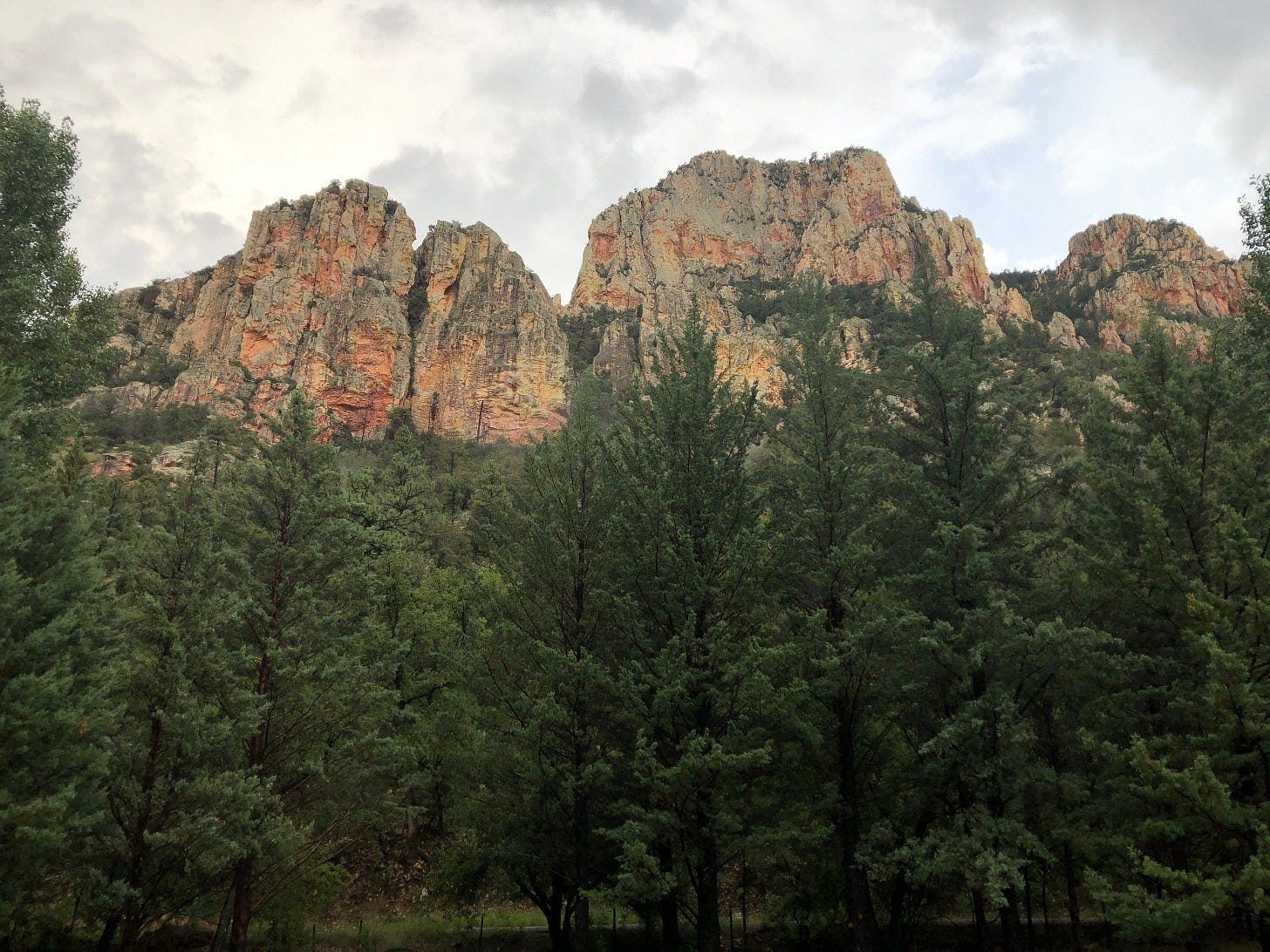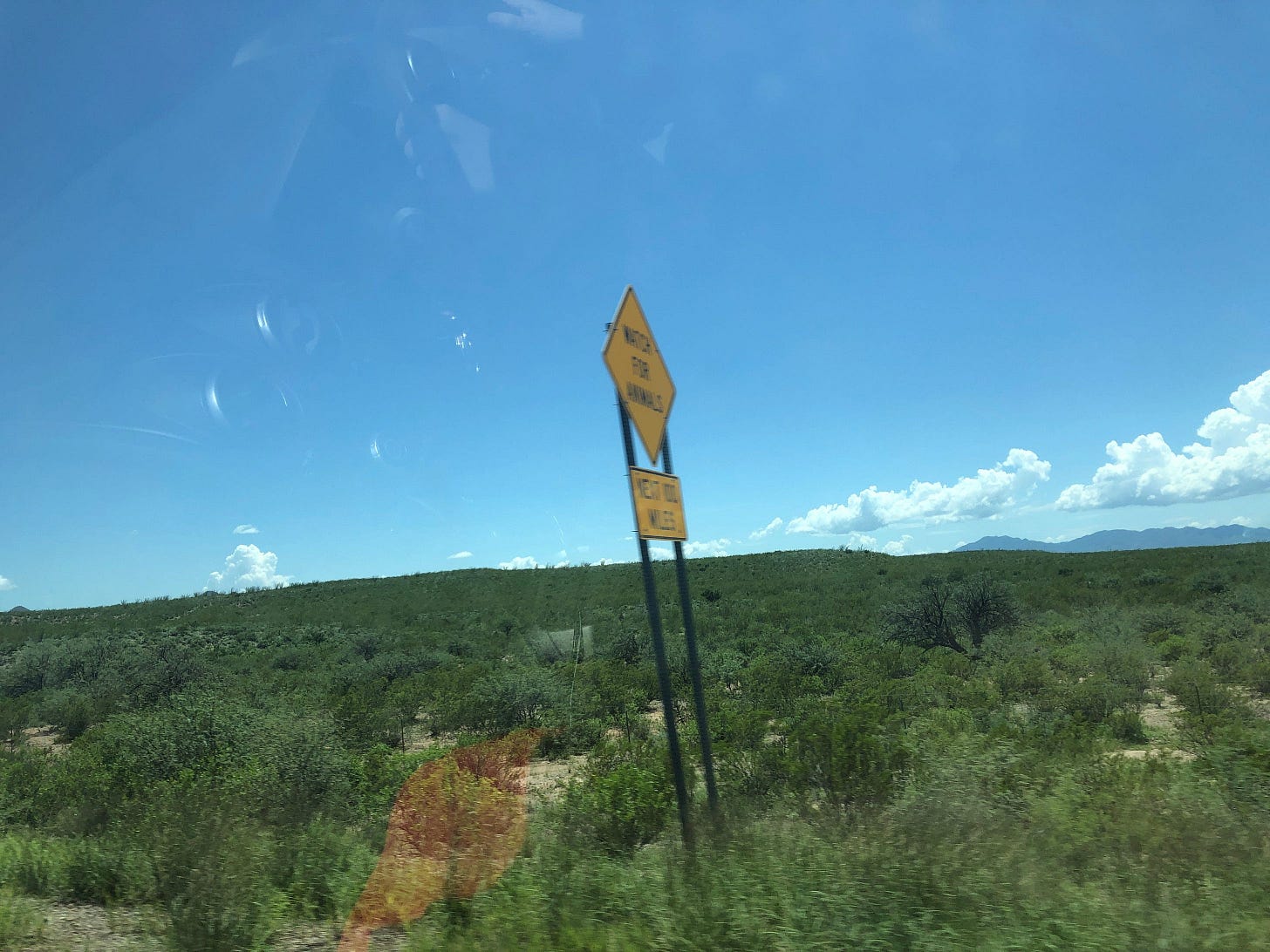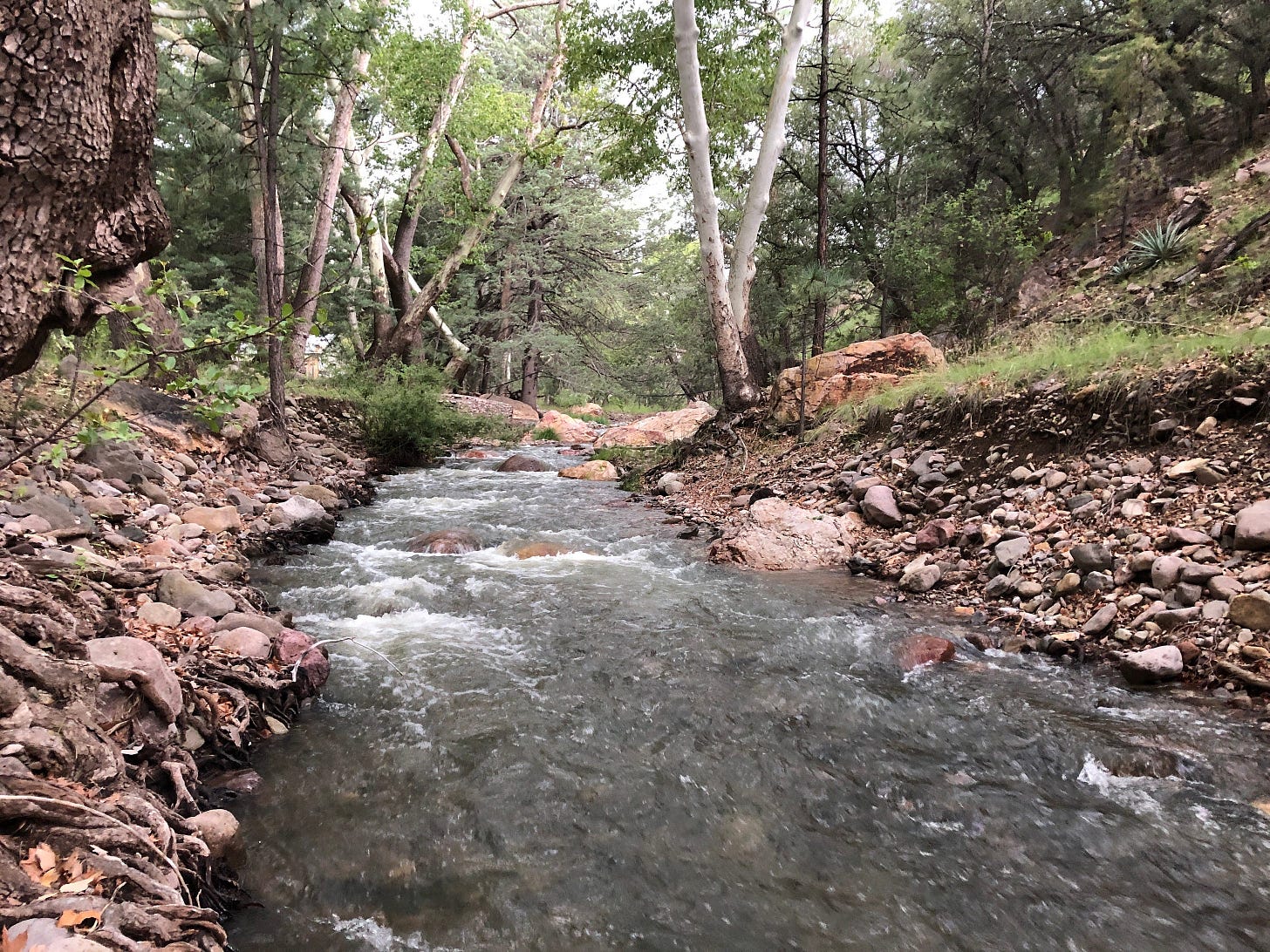Pods, Domes and Faux-Phones
back in the clubhouse, baby!
Annnd we’re back! Our last newsletter was a full 2.5 months ago, but honestly it feels like longer. In the time since we last corresponded, I
got COVID
got a COVID rebound
recovered just in time to drive to San Diego to
attend the UCSD Clarion Workshop for six weeks, during which I
critiqued ~18 short stories a week (many of them brilliant)
wrote five new short stories (some of them okay)
learned from great writers, including Geoff Ryman, Greg van Eekhout, Sam J. Miller, Ted Chiang, Gwenda Bond and Christopher Rowe (buy their dang books!!)
threw myself into the Pacific a bunch (sea wouldn’t take me, alas)
stared at a lot of sunsets (all perfect)
road tripped around California for a week with C——sorry if we didn’t connect
made it home in one piece. Whew!
I’m coming off the summer with a lot of ideas to chew over, for the foreseeable future I’m going to be headlining these newsletters with speculative craft/theory discussions, starting with
Pods, Domes, and Un-Phones
Often sci-fi stories live in mixed company with fantasy, so when one writes about the future, it can help to find a quick-and-dirty way to let the reader know that’s when they are. A story opening with the protagonist looking out a window at a traffic jam of hovercars puts the reader in a very different mind than a window looking out on a courtyard of knights and horses. These kinds of establishing details——often not critical to the themes or plot of the story——can be where writers rely on tropes.
Tropes are useful. A lot of the appeal and art of genre fiction comes from understanding and playing with tropes. The problem with tropes about the future, however, is that by the time a concept is well-known enough to become a trope, it’s often already obsolete, the past’s idea of what the future would be like. And once tropified, they sit in our speculative vocabulary confusing our ability to think clearly about technological and social change.
So I’m going to lay out my gripes against three tropes that are still in use that I’d like to see die.
Pods = a dream of reduced complexity
Last year when I was reviewing some 500+ stories for Grist’s Imagine 2100 climate fiction contest, I found myself awash in pods. Characters would take a transport-pod back to their living-pod, where they’d climb into their sleep-pod. (Not usually all in the same story, of course, but you get the idea.) I took to Twitter to demand a moratorium on pods in SF.
The pods-trope signals futurity by taking a traditionally non-round thing (house, car, bed) and making it round. This trick dates way back——think The Jetsons (welcome to the world, baby George!). A lot of that imagery was riffing on rocketry and general aerodynamics. But the thing is, you only need to be sleek and smooth and round like that when you are either moving real fast through an atmosphere or pressurizing the interior. On the ground, there are big advantages to right angles. The standardized and stackable shipping container is one of the most successful innovations in history. And as someone who hangs a lot of frames around my home, I cringe at the idea of putting art up on curved apartment walls.
But pods are also a dream of reduced complexity. Pods are both singular and generic. When someone lives in a pod, it implies that everyone (or at least everyone in that economic strata) lives in a pod. When vehicles are pods, it’s because that one type of thing defines the entire transport system. You rarely see a character riding a pod home while next to them in traffic someone is driving a Mercedes or taking the bus. All of which feels like a step backwards when naming brands and talking about product specs was one of the innovations that made cyberpunk feel so fresh 40 years ago.
The truth is we spend a good chunk of our time and mental energy parsing and navigating distinctions within categories. We make a big deal about the differences between a bus and a Mercedes and a Kia and a Tesla, and between different models of Tesla, and different years of models. We don’t just have homes: we have studios, apartments, lofts, penthouses, townhouses, rowhouses, cottages, ranch styles, two-storeys, McMansions, actual mansions, etc. It matters whether one sleeps on a twin, a full, a queen, an airmattress, or in some fancy pod. One size doesn’t fit all.
“Feed” does similar eliding of complexity when used to refer to futuristic internet content streams——when in fact millions of us spend a ton of time bouncing between email, Twitter, Facebook, Instagram, Discord, Tiktok, Tumblr, et al, and both consuming and posting differently on each based on carefully learned expectations, norms and strategies.
All of which can feel exhausting, hence the appeal of the dream of reduced complexity. I understand the utopian yearning to simplify, to untie the knots and tidy up the mess. But doing so would take an unprecedented historical rupture. I’m mostly pro-rupture, but I also think that even were we to get one, the world on the other side would most likely be just as complicated, but in different ways. And without a rupture, I think it’s a better bet the future is not going to be more complex than the present, not less.
Domes = a fantasy of preserved normalcy
Just like pods are used to tell the reader they’re in a generic sci-fi, I’ve seen domes deployed to efficiently tell readers they’re in a cli-fi. How do you convey that the air outside is fucked and the sky is scary, without making your characters actually suffer the consequences of being outside? Put a dome over it!
This trope too has a classic sci-fi origin, from pictures and descriptions of moon and Mars bases. Again, the futuristic roundness comes from needing to pressurize the interior. But on Earth, even if you are trying to keep bad air out, you don’t need to pressurize, just filter.
If you are going to move people into a sealed, climate-controlled facility, an apartment building is a way more sensible plan. Or look at the kind of malls they build in Dubai and Saudi Arabia. What makes little sense is taking an existing community——usually a town full of single family houses with picket fences and grass lawns——and slapping a dome on top.
Domes are a quick way to turn a climate story into a parable about haves and have-nots; who has privilege and who doesn’t is illustrated neatly by who is inside versus outside the dome. And I’ll be the first to stress that inequality is a big part of how the climate crisis will likely play out. The third section of my recent book, Our Shared Storm: A Novel of Five Climate Futures, is a story about how arcology walls might amplify climate impacts for those in the slums next door. What bothers me about domes isn’t that sentiment, it’s the fantasy they sell of preserved normalcy.
Because too often domes are imagined to specifically project something that amounts to a middle class suburban neighborhood or small town full of nuclear families. It’s a “cozy catastrophe” vision of climate collapse, where the primary impact is confinement rather than displacement. It’s a type of story that centers those who have experienced the least amount of change. Rather than, say, the climate refugees who end up packed together with strangers in camps or shelters or holding facilities, whose family units are torn apart or perhaps become porous.
Who is going to pay to dome these small towns? Capitalist funders don’t want to save this middle American way of life with a hefty-yet-minimalist piece of infrastructure that preserves old housing stock——they want climate disaster to force homeowners to buy into (or become renters at) flashy, highly financialized new housing developments. Governments are going to be big funders of climate adaptation, but unless domes are dirt cheap (which, who knows, maybe they will be), relocation seems way more efficient per capita.
Sometimes we talk about how hard it is to imagine the end of hegemonic systems like capitalism (easier to imagine the end of the world, etc.). I think the mid-20thC suburban home has a particular stranglehold on our (American) sense of normalcy and possibility. I’m guilty myself of writing about big climate infrastructures plopped down on top of single family houses. But rather than imagining the hoops we might jump through to preserve this one way of life in an increasingly inhospitable world, I think it may be more intellectually honest and useful to write about how normalcy is shattered and perhaps reinvented.
Faux-Phones = a tick of unnecessary innovation
That said, there are some reinventions of the normal that I think don’t hold up (see Pods above). One that I’ve become skeptical of is wearables. It’s another quick signpost: you can tell readers they’re in the future by having a character send a message or make a call using not their smartphone but their glasses, contact lenses, or wristwatch.
I just don’t buy the idea that the smartphone is going to be made obsolete by something we attach to our bodies. We have smartwatches, sure, but they are extensions of our smartphones, not replacements for them. Google Glass was a failure. There have been promises about coming contact lens displays for long enough that I’ve turned skeptic. But sci-fi is often still carrying a torch for wearables long after industry has gotten over the hype.
My thinking on this has been heavily influenced by this 2014 presentation, which remains a great read. It explores how predictions about a future of supersonic jets never came to pass, how air travel settled on the Boeing 707/747/787 as a “good enough” technology, and what that means for web design and other sectors.
I think the hand held, touchscreen smartphone (or tablet!) is a “good enough” technology that won’t be——and doesn’t need to be——reinvented or turned into a wearable. Examined critically, the sci-fi wearable versions of the smartphone usually has big disadvantages. I’m sure the future could make a wristwatch much more powerful than our modern iPhones, but such a device would be less useful because the screen real estate would be significantly cut without shrinking human fingers to match. We could keep the screen the same size, but why would I strap on a “wristpad” that constrains my movements——I can’t type on it with both hands at once, nor can I use it well one handed, nor hold it up like a camera, nor hand it easily to a friend——when I can carry my phone in my pocket?
I think we also underestimate the social weirdness introduced by putting your personal computer on your face. How are people supposed to have a meaningful conversation with you when a) you could be reading/watching something else while they are talking, and b) you could be photographing/recording/streaming everything they say? Sci-fi often depicts those options as features rather than bad behaviors. Like, the whole point of “gargoyles” in Snow Crash was that they were antisocial weirdos. We’ve all gotten a bit used to ubiquitous cameras, but the point is a phone can be put away, so that you can demonstrably give someone your attention. A phone can be taken out and held up to show that you are going to take a photo. There’s an etiquette here that the handheld form of the phone makes possible.
When I first got reviews of my Our Shared Storm manuscript, I got a comment wondering about why my characters, 30+ years in the future, were still using smartphones. Wouldn’t we have invented some strange and fantastical replacement by then? But today the cars we drive, the planes we ride, the houses we live in are all basically identical in form and function to those we had 30 years prior.
Faux-phone wearables are a tick of unnecessary innovation. It’s making a scene feel futuristic for its own sake, rather than saying something about the future. Just give your future people phones and figure out what futuristic things they might be using them to get up to.
Places I’ll Be (Some Rescheduled)
St. Louis, August 20 (Saturday @ 2-4pm CDT), The Book House
St. Louis, August 25 (Thursday @ 7pm CDT), Left Bank Books
Zoom, September 8 (Thursday @ 6:30pm EDT), All But True
Tucson, September 24 (Saturday @ TBA), Revolutionary Grounds
Press Clips, Reviews, Interviews, Etc.
I had a nice little bit of press trickle in while I was away at Clarion over the summer. Here are some highlights:
Michael Burnham-Fink wrote a fantastic review of Our Shared Storm on Goodreads, and adapted it into an article for Majority Post. Seriously, even if you’ve already read Our Shared Storm, go read this. He makes a bunch of excellent points about climate fiction that I wish I’d made myself!
Adam Kaufman wrote a great piece about my book for Fordham Magazine. Adam and I both worked on one of Fordham’s student newspapers when we overlapped by a couple years in undergrad, so this was a really fun conversation.
Also at Fordham, I appeared on this segment talking with WFUV’s David Escobar about building a working class movement for climate action.
And I returned to The Fire These Times podcast to talk about my book and post-normal fiction with the always thoughtful Joey Ayoub.
Our Shared Storm got this fun Youtube review. Please show the creator some love!
Finally, a couple projects I contributed to (Multispecies Cities and Imagine 2200) are finalists for the inaugural Utopia Awards.
Art Collection
In a recent quick trip to the Bay, C and I got to visit the huge Diego Rivera exhibit at SFMOMA. I’ve along enjoyed Rivera’s work as someone who put a lot of effort into depicting and glamorizing both working people and class struggle. This is one of his weirder pieces, which nonetheless jumped out at me enough that I took home a print as a souvenir. (Above is a photo of the original, not my as-yet-unframed print.) It reminds me a bit of the Torque-warped lands of the Cacotopic Stain in China Miéville’s Iron Council.
Material Reality
Though I’ve been yearning for some simple time back at home, C and I have spent the last few days in a friend’s cabin, out in the Chiricahua Mountains of southeastern Arizona. They are fully kitted out here, with rooftop solar, a powerwall, satellite internet, and clean spring water. Plus an incredible view of high canyon walls on both sides.
What’s been most amazing is how wet and green everything is. Seriously, right now everything south of Tucson looks like the rolling hills of The Shire. On our whole drive up and down California, C and I kept noticing just how *crispy* that state looked. The megadrought continues apace (climate weirding floods in Death Valley excepted). But Arizona has had a relatively wet summer——or at least an actual monsoon, instead of the dreaded “nonsoon.” And the Chiricahuas often get the first and last rain to hit the state.
It’s stormed off and on the whole time we’ve been here, including some of the biggest rains they’ve gotten all season, apparently. (A small private book event our hosts had kindly planned was almost scuttled because many of their RSVPed neighbors were trapped for the evening by overflowing stream crosses and muddy dirt roads.) The creek a couple dozen meters from our cabin is a noisy shush. And all around grass is sprouting tall and otherwise arid landscapes are lush and verdant.






